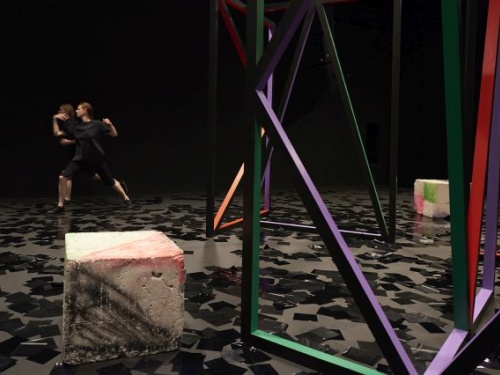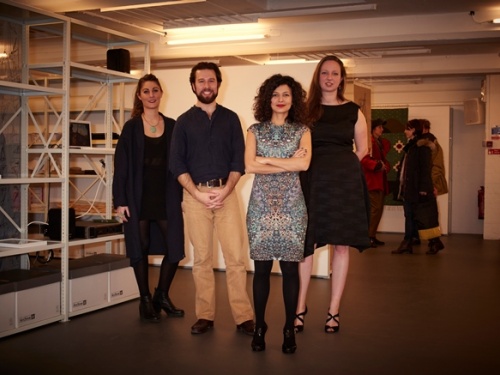Configuring Prefigurativeness, Reconfiguring Figments: A fig-2-pedia
fig-2 presents 50 projects over 50 weeks in the ICA Studio in association with Outset. Here, curator and artist Mary Vilardo responds to fig-2 as a whole, concentrating on weeks 25-37.
In 1959, Smithsonian Folkways released Indeterminacy, Ninety Stories by John Cage, with Music: Cage read stories in random order from cue cards, while David Tudor played out of earshot in another room, mixing live selections from Cage's Concert For Piano And Orchestra with pre-recorded tapes from Cage's Fontana Mix. These multidisciplinary layers of interpretation were the result of an assemblage of basic instructions that, by their pure juxtaposition, relied on chance and indeterminacy.
Flash forward to contemporary art happenings: fig-2 is one of those typical/atypical and liner/non-linear representations of unsuspected indeterminacy. Spanning 50 weeks and presenting 50 projects, it could appear as a well-synchronised art-show-making-machine. Yet, the information about every week-long exhibition is broadcasted on the Wednesday before each opening, the spatial configuration is for-ever dissembled and re-assembled and the artistic output is generated through fast-paced feedback between the curator and the artist. Through this loop indetermination thrives and grows: the audience keeps coming back, driven by the surprise effect and the seven-day-cycle repetition; the artists create laboratories of research which act as seeds for upcoming projects.
During these processes, curator Fatoş Üstek intercedes as facilitator to trigger a multitude of correspondences but gives carte blanche to her interlocutors, eliciting a highly-controlled indeterminacy which renders differences and heterogeneous artistic practices week-by-week via assimilation and continuous transformations. As in the Cageian Indeterminacy instructions, fig-2 presents a set of stories and artistic arrangements, which are ordered-in-progress and respond to site-specific layouts, delivering a delicate balance of control and chance. Attempts of chance procedures techniques are looped, for example, in Anna Barhamʼs (30/50) digital dictation paradigms, in which the original text is put through repeated processes of being read by members of the audience to a computer and mangled by a voice recognition software. The sense, the meaning and the significance are trashed by the physical and mechanical impossibility of capturing all the spoken words, resulting in a new version of the text, re-read and re-configured in a continuous flux of reproduction.
In pursuing thematics of interoperability between the subject-matter of art as an intuitive, idiosyncratic, indeterminate and un-regulatable process, I have played with the malleability of the contemporary art discourse, generating a fig-mental glossary, a fig-2-tionary.
ABOUT-NESS
Oreet Ashery (32/50) restyles an excerpt from TV series Alfred Hitchcock Presents in which the Master of Suspense explains a behind-the-scene radio show trick whereby a fire is evoked by applying friction to wrapping paper near a microphone. Amy Stephensʼ sculpture (35/50) replicates organic stone-like forms. Simulation—according to Baudrillard an active process of replacement of the real—is transfigured by the intentionality of the representation and artistic gesture generating about-ness.
CULT STATUS
Albeit an improvised cluster of systematic art happenings, fig-2 is a well-tested format following up the 50 projects in 50 weeks concept of fig-1, which was curated in an un-gentrified Soho by Mark Francis in 2000 and presented a programme of famous artists together with lesser-known names. The fig-n phenomena has built a cult status in history due its uniqueness-cum-seriality-cum-scalability. The concept has also proven to be future proof, with its basic fixed structure and free-style curatorial approach.
ENCYCLOPEDIC NOT-STOP CYCLE
Cataloguing, documenting, building cabinets of curiosity and classifying has been a leitmotif of fig-2. The collation of knowledge has often expanded over the boundaries of the ICA Studio space and the week-long exhibition, generating parallel instances—such as seminars, talks, yoga sessions—and long-term loop cycles. The participating audience was cast on site to be part of Revisiting Genesis, a web series with a feminist approach to digital afterlife and legacy. PostMatterʼs essays were extemporaneously written together by artists and published online. Karen Mirzaʼs open conversations on the Ectoplasm of Neoliberalism (27/50) trespassed the boundaries of art to include astrology and radical politics.
IN-BETWEENNESS
While structuring absence in between fig-2 exhibitions is not possible, the suggestion of another time—outside the strict seven-day schedule—is hinted at through the expanded duration of some of the projects. Melanie Manchotʼs subject in Reverse [11/18] (37/50) is filmed analogically every month for one minute, for seven years, activating a notion of time escapism from the now-and-then and automatically generating a juxtaposition with the short duration of the on-site screening installation. Veronika Haur (34/50) induces an ongoing in-preparation performance status by delaying the activation of the performance piece and relying on the audience perception of the subtlety of the non-act.
CONFIGURING PREFIGURATIVENESS
Design studio El Ultimo Grito (33/50) present their exhibition retroversively by building the individual elements into a construction that starts at the beginning of the week and comes to total fruition by the end of the show. By configuring their production into studio process-based stages, they instigate the conceptuality of both short- and long-term prefigurativeness: their representation of glitchy digital maps leads to the investigation of prototyped built-in environments and urbanscapes in which future cities are prefigured by the citizen/user. Dystopic semi-constructed environments are also the scenography for Cecilia Bengolea, Celia Hempton and Prem Sahib (25/30) in which plasticity, materials, tactics and the sonic are choreographed evoking Michel Foucaultʼs discourses on power, gender, and sexuality.
LONG-DURATIONAL
Perceived as a fragmented marathon of artistic outputs, fig-2 assumes long-durational status, not only for its enduring organisational aspects but also for the continuous circular formula of exhibition in progress: except for the opening/closing site-specific times, there are no gaps and pauses. Every week becomes a time-capsule that is filed and historised to be released at the end and collected in the final catalogue; the accumulation of events will generate retrospective theories and critiques of the overall project that are yet to be formed in completeness.
NARRATIVE
Intertextuality and narration by assemblage are recurring themes. Patrick Coyle and Francesco Pedraglioʼs output (28/50) deconstructs pre-existing narratives (Edoardo Sanguineti, Purgatorio dellʼInferno, 10) and linguistic diacritical marks (a cedilla) giving new context and therefore new autonomy to the subjects. Taking a writerly approach, Pedraglio recites altered versions of Sanguinetiʼs poem and every time a narrative milestone is achieved, he adds evocative objects on monochrome lines depicted on the wall: a smoking cigarette as the locomotive, a postcard from Finland, a red thread as the long North-South distance of an Italian motorway. In correspondence, Coyleʼs placement of a variety of purple-coloured objects as part of a single work requires the audience to engage in making connections between the parts and decoding the associative play-word about a cedilla which is “found floating in the liquid hypnotic elixir and Açaíphabet seeds at the bottom lapping the sides and last times.”
RITUALS
fig-2ʼs seriality forms patterns of repetition that aggregate from each distinctive exhibition. The ritualistic fashion assumes substance in both standard curatorial procedures (the private view, the exhibition tour) and unorthodox practices (the loyalty card scheme, the weekly artist-commissioned gin and tonic). The permanence and accumulation of these sets produce a community-shaping sense of affiliation, making the audience participate in the ritual mechanisms with its systemic attendance.
UNSEEN SOUND
Sound as descriptive function and background noise is accomplished in Anne Hardyʼs proposition (26/50), where recorded sonic snapshots of her objects-assembling processes (the pouring of cementʼs blobs, the hewing of the wood, the scratching of a metal bar carried to her studio) become the soundtrack and acoustic mapping for the installation. By liberating the sound from its referent, the acousmatic features of her installation manage to give the audience the imaginary experience rather than the object of the installation itself, triggering impromptu relations between the artistʼs private practice and the public presentation. This compilation of unseen activities associated to unseen sounds again activates indeterminacy principles and processes that become the final artistic gesture. ■
fig-2 runs for 50 weeks in the ICA studio, presenting a new project every week of 2015.
This article is posted in: Blog, Events, Exhibitions
Tagged with: fig-2, fig-1, Mary Vilardo, Fatos Ustek, Exhibitions, events, ICA Studio, Experimentation, Interdeterminacy, John Cage








